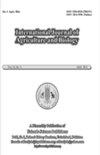Characteristics of Canary Hair Sheep´s Breed Carcass Fed Banana (Musa acuminate) By-Products: Effects on Regional Tissue Composition, pH and Color
Q2 Agricultural and Biological Sciences
引用次数: 0
Abstract
The contributions of replacing rye-grass (Lolium spp.) hay with banana (Musa acuminata) by-products on carcass and tissue characteristics, pH and color, in the Canary hair sheep breed were studied. Twenty-two lambs with an initial live weight of 14.8 ± 2.5 kg were individually housed and fed two different diets for 58 days: The first group (experimental diet) received as forage a mixture of fresh banana (Musa acuminata) by-products composed by leaves and pseudo-stem. The other one got commercial rye-grass (Lolium spp.) hay (conventional diet) as a fiber source. The two groups got an additional commercial concentrate food (CON). After the 58 days growing trial (24.3 kg ± 1.0 kg), seven lambs of each group (n=14) were slaughtered in the experimental slaughterhouse. The muscle, the pH, and the color were measured at the time immediately after slaughter and 24 h later, using the muscles Longissimus thoracis et lumborum and semimembranosus. At that time (after 24 h), the remaining semi-carcass was butchered and dissected for analysis of the carcass´s regional and tissue composition. Although there is no significant difference on the tissue composition, carcass regional and the muscle pH, there are significant differences in the color in the Longisimus toracis et lumborum between the two assessed diets. The incorporation of banana by-products in a diet to fatten lambs Canary hair sheep breed would not grossly alter the carcass quality, at least based on the assessed parameters. Banana by-products as a feeding resource can maintain animal productivity and meat quality. © 2021 Friends Science Publishers香蕉(Musa acuminate)副产品饲养的金丝雀毛羊胴体特性:对区域组织组成、pH值和颜色的影响
研究了用香蕉(Musa acuminata)副产品代替黑麦干草(Lolium spp.)对金丝雀毛羊胴体和组织特征、pH值和颜色的影响。将22只初始活重为14.8±2.5kg的羔羊单独饲养并饲喂两种不同的日粮58天:第一组(实验日粮)接受由叶子和假茎组成的新鲜香蕉(Musa acuminata)副产物的混合物作为饲料。另一种以商业黑麦干草(传统日粮)作为纤维来源。两组获得了额外的商业浓缩食品(CON)。经过58天的生长试验(24.3kg±1.0kg),每组7只羔羊(n=14)在实验屠宰场屠宰。在屠宰后立即和24小时后,使用胸腰最长肌和半膜肌测量肌肉、pH和颜色。当时(24小时后),对剩余的半胴体进行屠宰和解剖,以分析胴体的区域和组织成分。尽管在组织组成、胴体区域和肌肉pH值方面没有显著差异,但两种评估日粮之间的长腿龙的颜色存在显著差异。至少根据评估的参数,在育肥羔羊的饮食中加入香蕉副产品不会严重改变胴体质量。香蕉副产品作为一种饲料资源,可以保持动物生产力和肉质。©2021 Friends Science出版社
本文章由计算机程序翻译,如有差异,请以英文原文为准。
求助全文
约1分钟内获得全文
求助全文
来源期刊

International Journal of Agriculture and Biology
AGRICULTURE, MULTIDISCIPLINARY-
CiteScore
1.70
自引率
0.00%
发文量
40
审稿时长
5 months
期刊介绍:
Information not localized
 求助内容:
求助内容: 应助结果提醒方式:
应助结果提醒方式:


